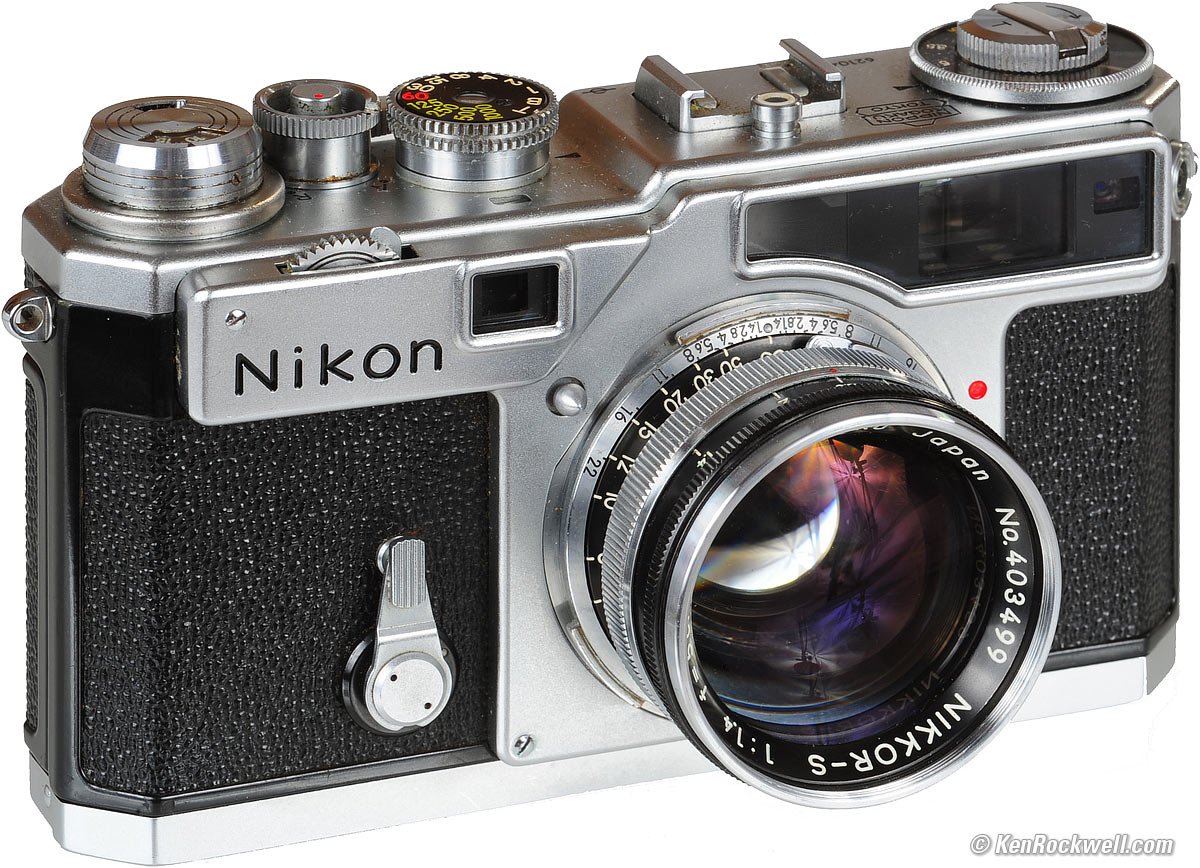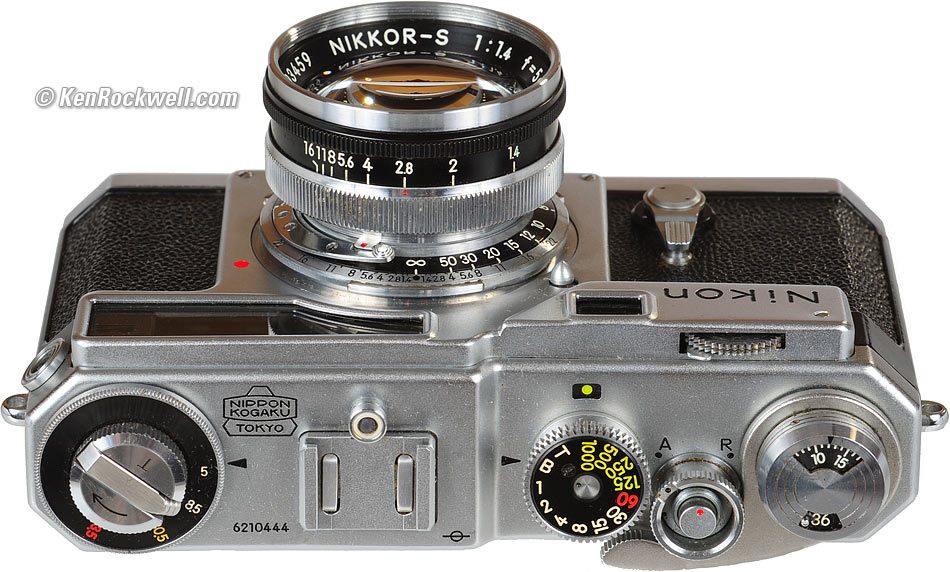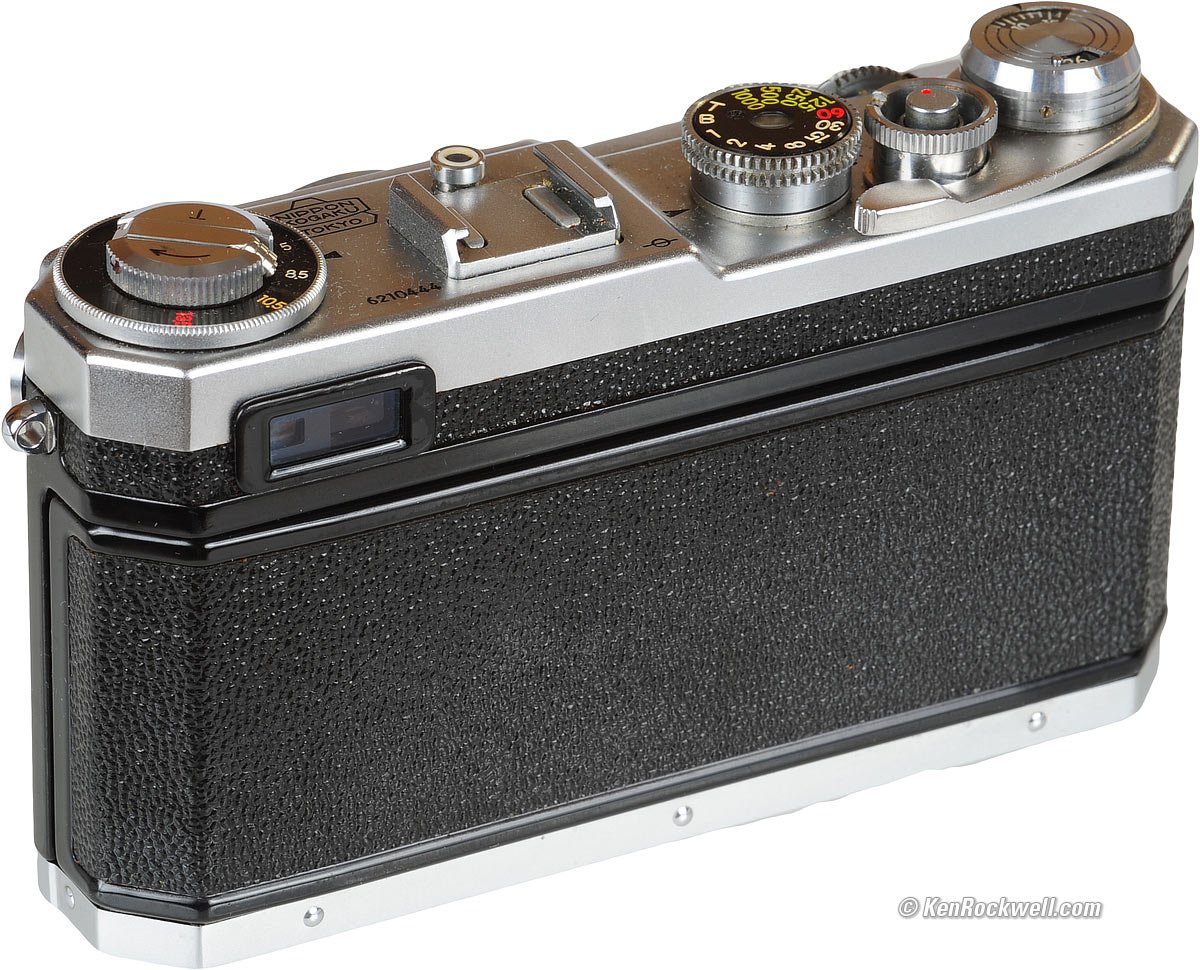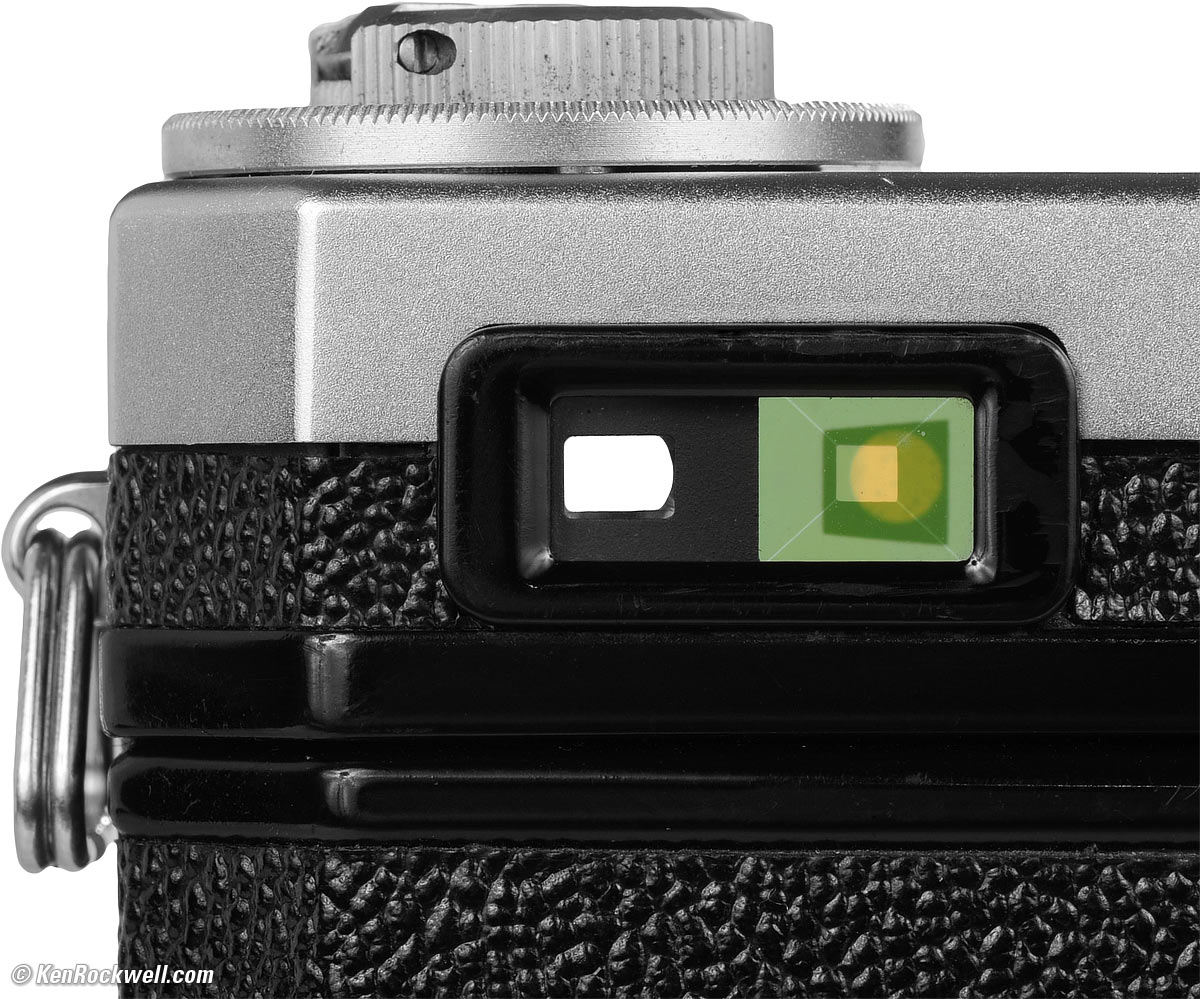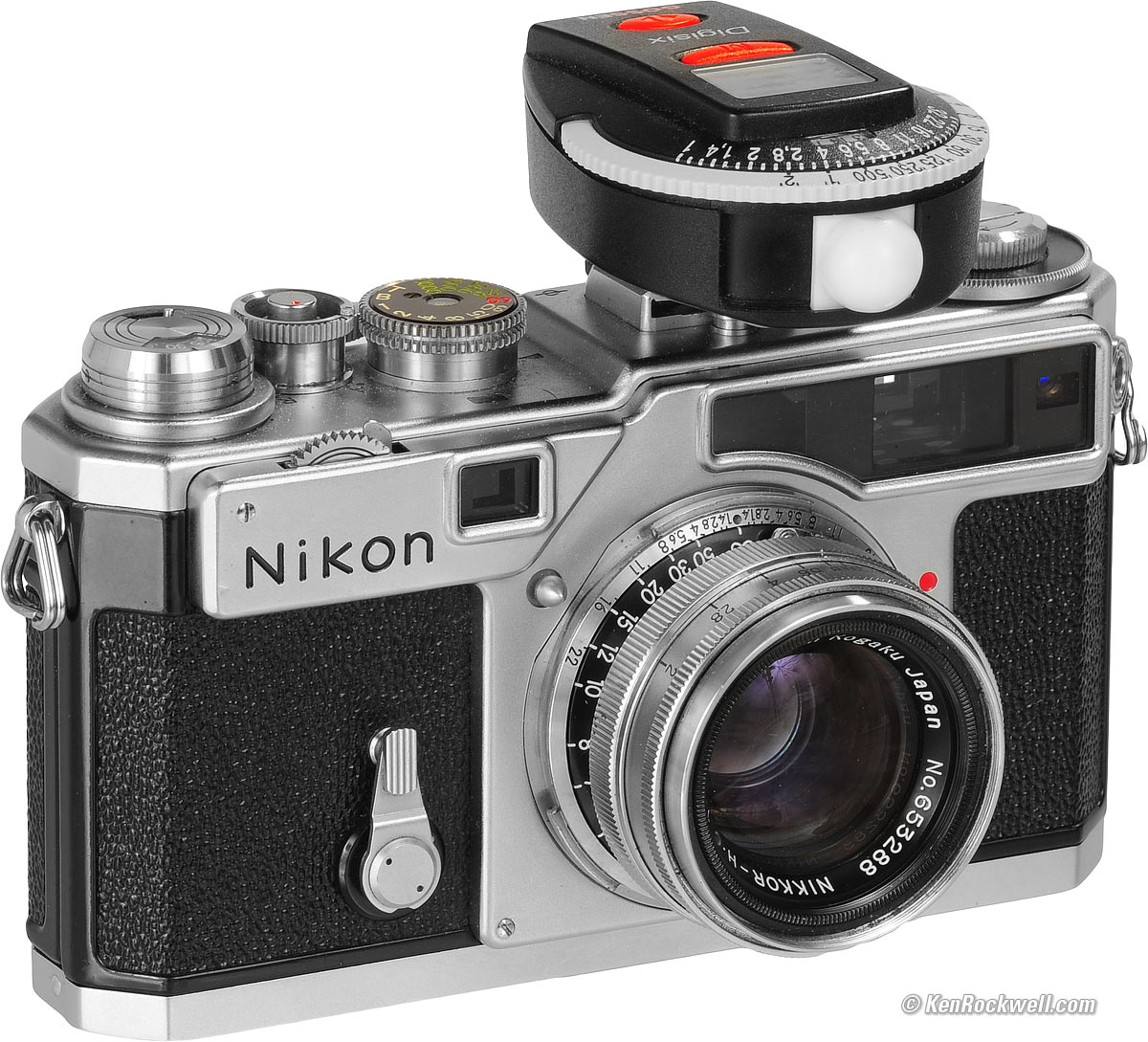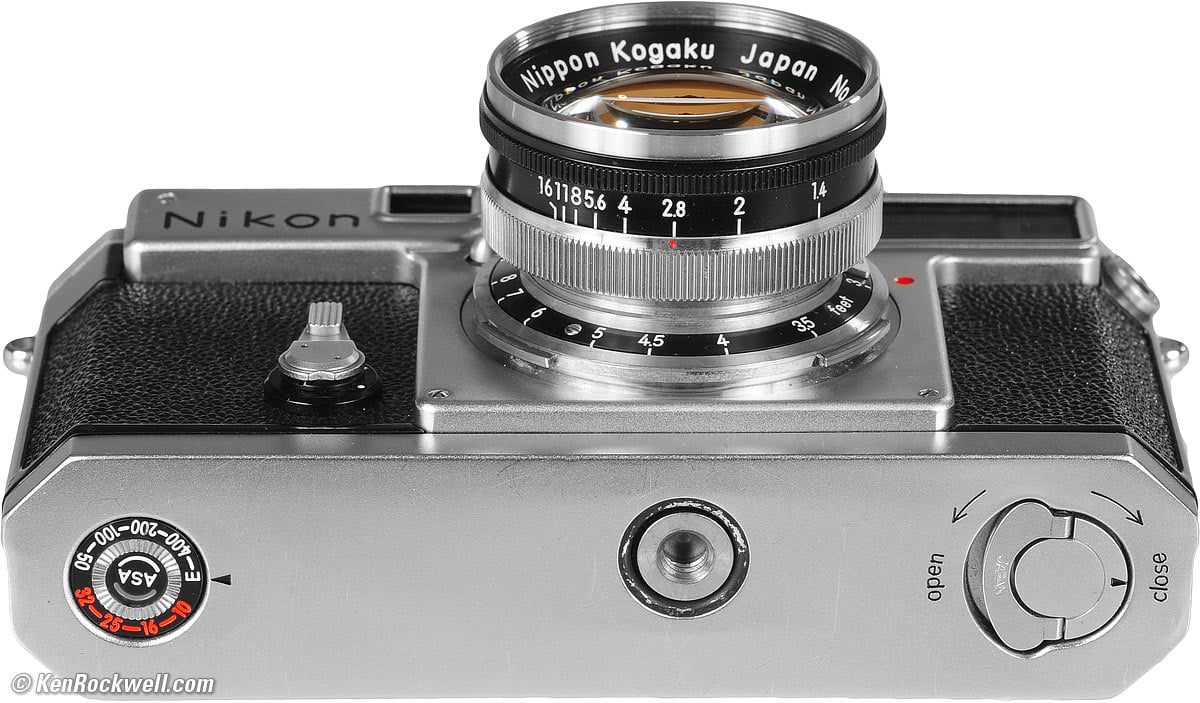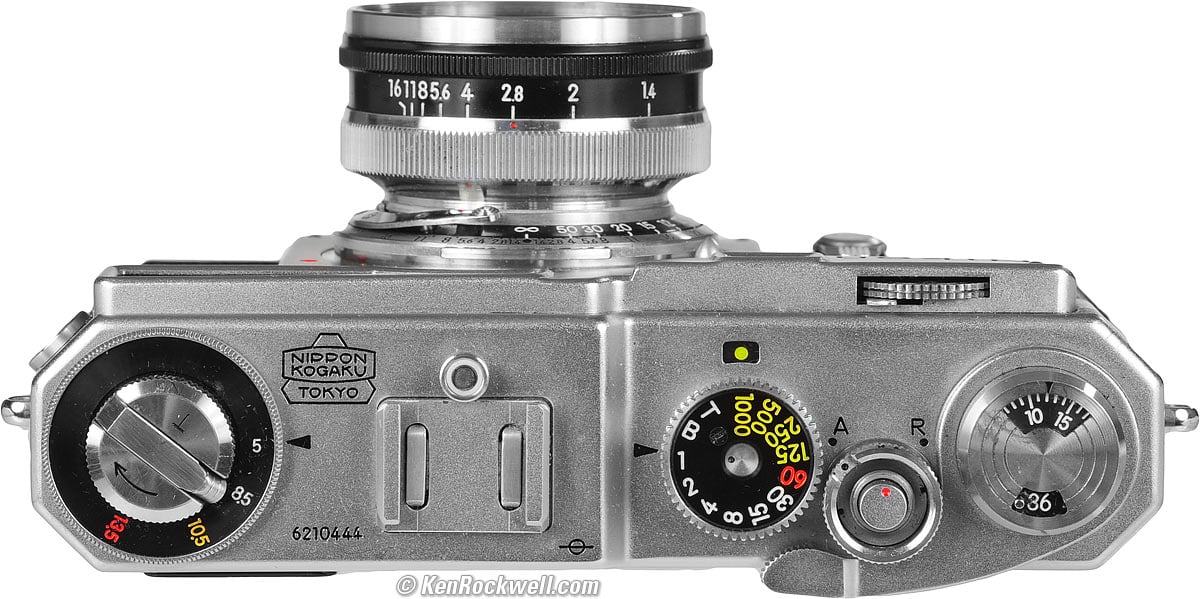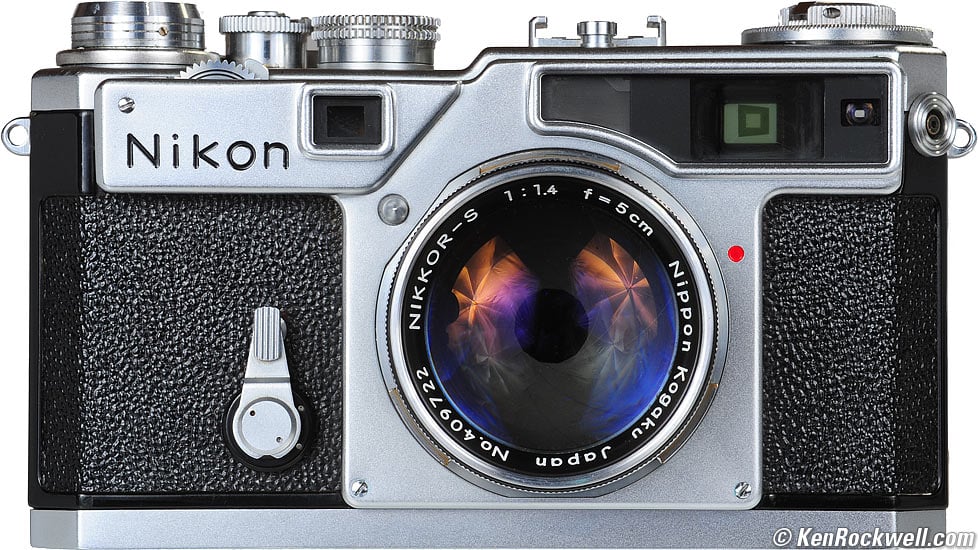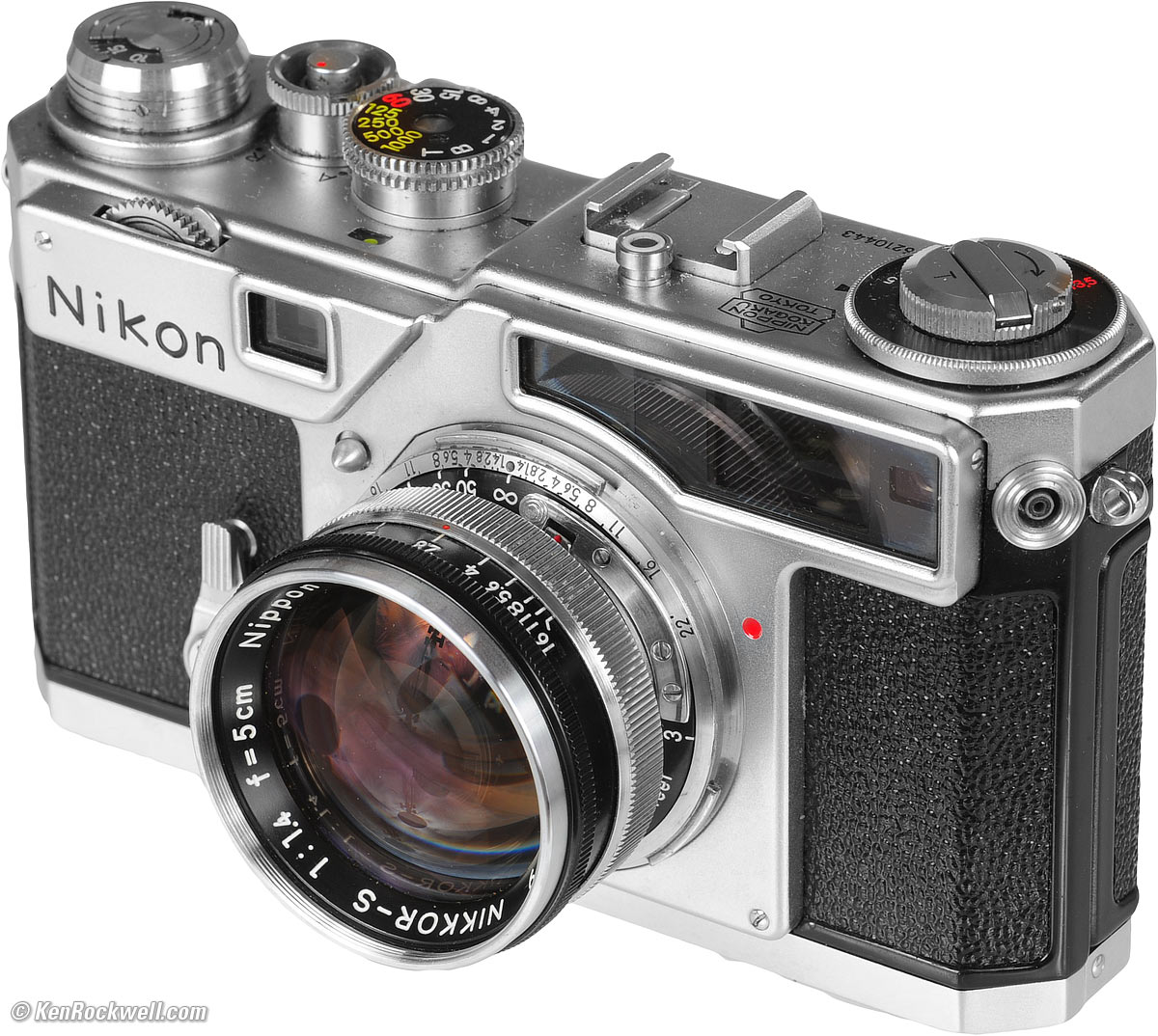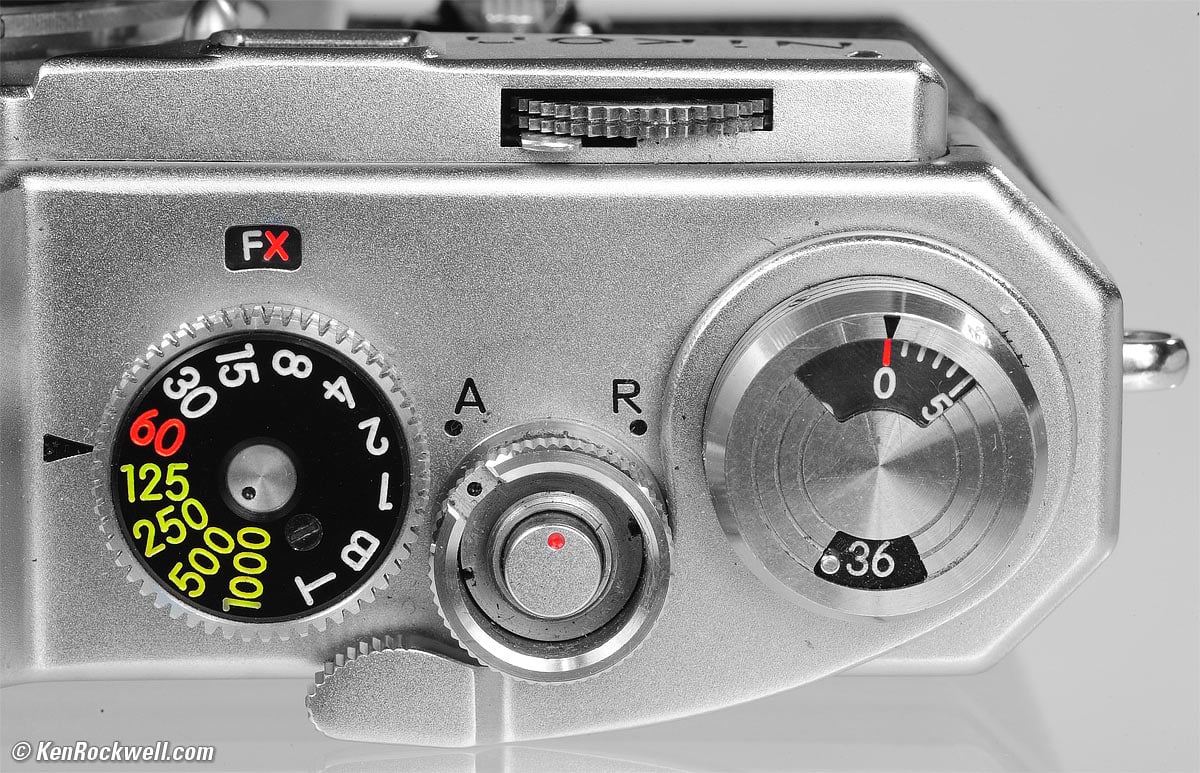Home Donate New Search Gallery Reviews How-To Books Links Workshops About Contact
Nikon SP (1957-1962)
World's First Professional Nikon
Intro Specs Performance Compared Usage Recommendations
Nikon SP (Nikon S lens mount, 21.3 oz./603g with film, about $1,500) and NIKKOR-S 5cm f/1.4. enlarge. My biggest source of support is when you use any of these links, especially this link directly to the Nikon SP at eBay (see How to Win at eBay), when you get anything, regardless of the country in which you live. Thank you! Ken.
April 2019 Better Pictures Nikon Rangefinder System Nikon System All Reviews
Why Fixed Lenses Take Better Pictures
Top, Nikon SP and NIKKOR-S 5cm f/1.4. enlarge.
Back, Nikon SP (note two finder windows inside one larger bezel). enlarge.
Introduction top
Intro Specs Performance Compared Usage Recommendations
Lens Compatibility History Price
|
|
The Nikon SP is a wonderful camera today. The Nikon SP is much smoother and quieter than today's SLRs and DSLRs, with a super-smooth shutter release.
The Nikon SP is Nikon's first professional camera. The Nikon SP is a rangefinder camera, not an SLR. It is also Nikon's first camera with a self-timer.
The Nikon SP is an exercise in 1950s Japanese luxury. Everything, except the razor-wheels of the focus and shutter dials, are smooth and sweet, especially the silk shutter, silent shutter sound, film wind and shutter release.
Back in 1957, the Nikon SP was also the world's first rangefinder camera with a built-in 28mm finder.
Excellence never comes cheap. Just like the Nikon's two professional cameras today, the D3X and D3s, Nikon's professional cameras have always been priced out of the reach of all but the richest amateurs. This was about a $3,500 camera in its day, corrected for inflation. You'll see it on the cover of Bob Dylans's "Highway 61 Revisited" from 1965.
The Nikon SP was Nikon's first and only professional rangefinder camera. Earlier and later models were lesser cameras.
The Nikon SP was Nikon's attempt to copy and improve on the incredible LEICA M3, at a lower price. The LEICA M3 is a better camera than the Nikon SP, however Leica has lost so much over the years that today's klunky LEICA M9 isn't as nice to use as the Nikon SP. The Nikon SP is much smoother, quieter, more pleasant to use and has a far superior finder to the LEICA M9.
The SP uses a clip-on Nikon selenium meter (not shown), almost all of which are dead today. It couples to the shutter speed dial, so all you need to is read the aperture and set it on the lens.
Even if Nikon's selenium meter is working, its angle-of-acceptance isn't particularly selective. Either of Leica's coupled LEICAMETER MR or LEICAMETER MR-4 coupled LEICAMETERs are far superior.
Dual Finder Windows, Nikon SP (main finder is on right). enlarge.
I often use a Gossen Digisix meter with my Nikon SP:
Gossen Digisix on Nikon SP with 5cm f/2. enlarge.
Nikon's first SLR, the Nikon F of 1959, is actually the Nikon SP with a grafted-on prism!
I'm reviewing an original Nikon SP with the Habutae silk shutter. Nikon changed the shutter to titanium foil in 1959. Titanium is far more resistant to holes being burnt through it if an uncapped lens is pointed at the sun, but probably not as quiet. The titanium-foil shutter Nikon SP was the world's first camera with a titanium shutter.
Bottom, Nikon SP (note color/B&W ASA reminder). enlarge.
Top, Nikon SP and NIKKOR-S 5cm f/1.4. enlarge.
The parallax-correcting finder is life-sized, bigger than any LEICA, ever. Unlike any LEICA, it's trivial to shoot with both eyes open.
The main finder covers a 50mm lens, and as you turn the top dial around the rewind crank (marked 5cm, 8.5cm, 10.5cm and 13.5cm), frames for 85mm, 105mm and 135mm lenses appear.
Nikon SP and 5cm f/1.4 (secondary finder is to right of main finder.) enlarge.
The Nikon SP uses the Nikon's S bayonet mount. The S-mount is compatible with all Nikon rangefinder bodies, but completely incompatible with any of Nikon's SLR system, which has used the F mount since 1959.
The S-mount is copied from Contax, whose lenses also mount. The gotcha is that Contax' 50mm lenses had slightly different focal lengths from Nikon's, thus the rangefinders become progressively less compatible at closer distances.
Nikon made all sorts lenses, from a 21mm f/4 through a 50mm f/1.1 (!) to a 1,000mm f/6.3 (with reflex viewing attachment!) for this system.
For most people, lenses from 28mm though 135mm were most popular, and that's what you'll see most often today. The crazier lenses weren't very popular so collectors today have bid prices out of line for actual photography, while normal lenses usually sell for a couple of hundred dollars.
1930s
Nikon's first camera lenses were used on the very first Canon (Kwanon) camera of 1934. This wasn't any sort of competitive problem since Nikon didn't make cameras.
1940s
Before World War II, Nikon was primarily a manufacturer of military optical instruments. Nikon's products were used in Japan's terrorist attacks on Pearl Harbor on December 7th, 1941, and Nikon's bombsights, periscopes, large naval binoculars and ultra-long range optical rangefinders used with battleship artillery were instrumental in the deaths of many innocent Americans in World War II.
After America harnessed the power of the sun to stop Japan in the summer of 1945, Nikon's warmongering activities were disbanded as Japan was occupied by peacemakers.
The few employees left at Nikon wondered what to do. Shrugging their shoulders, they decided to make a small 35mm rangefinder camera for consumers.
1947
Nikon's first camera was the Nikon One. It copied the lens mount and top focus wheel of the Contax.
The Nikon One was followed by the Nikon M and Nikon S, and then the Nikon S2, which was the first Nikon to use Leica's now-standard 24x36mm full-frame. Earlier cameras used better, slightly less wide 35mm frames.
1957
Announced in September 1957, this Nikon SP, for Nikon S - Professional, added finder frames for every lens under the sun. It does this with a tiny second finder next to the main finder.
The Nikon SP was Nikon's attempt to steal business away from the extraordinary new LEICA M3 of 1955, using Japan's usual trick of adding sales features while lowering intrinsic quality. The SP added more finder frames than the LEICA M3, but with Nikon, you had to select them manually.
Year |
Format |
Finder Mag. |
Finder |
Top Speed |
|
| Nikon One | 1947 |
24 x 32mm |
0.60x |
50mm |
500 |
| Nikon M | 1949 |
24 x 34mm |
0.60x |
50mm |
500 |
| Nikon S | 1951 |
24 x 34mm |
0.60x |
50mm |
500 |
| Nikon S2 | 1954 |
24 x 36mm |
1.00x |
50mm |
1,000 |
| Nikon SP | 1957 |
24 x 36mm |
1.00x |
28, 35, 50, 85, 105, 135 |
1,000 |
| Nikon S3 | 1958 |
24 x 36mm |
1.00x |
35mm, 50mm, 105mm |
1,000 |
| Nikon S4 | 1959 |
24 x 36mm |
1.00x |
50mm, 135mm |
1,000 |
| Nikon S3M | 1960 |
18 x 24mm |
1.00x |
35mm, 50mm, 135mm |
1,000 |
Nikon's later rangefinder cameras were cheaper, simpler versions of the Nikon SP, much as LEICA's newer cameras since the 1950s have also been cheaper, simpler versions of the LEICA M3.
1959
Nikon replaced the Nikon's SP's original Habutae silk shutter with the same titanium shutter it used in the 1959 Nikon F.
Believe it or not, Nikon's first SLR, the Nikon F of 1959, is actually just a Nikon SP with a prism glommed on!
The shutter, layout, controls, and camera back are all otherwise the same between this Nikon SP and the Nikon F SLR.
NIkon turned this grafted-on prism kludge into a marketing ploy that worked all the way up to 1999, when the Nikon D1 was Nikon's first-ever professional SLR that didn't have an interchangeable prism!
Even the SP's removable back is the same in the Nikon F, except that the Nikon F is a little bit wider, but otherwise identical.
1962
By 1962, everyone had moved to the Nikon F SLR, or to the extraordinary LEICA M3, and Nikon's rangefinder cameras were promptly forgotten.
Nikon sold less than 23,000 Nikon SPs, which is why they gave up. LEICA sold 250,000 M3s. In fact, Nikon sold less than 140,000 rangefinder cameras in its entire history, or about half as much as LEICA sold of just the LEICA M3.
1970s
By the 1970s, Nikon's SLRs had pretty much killed off LEICA and the rangefinder market. Nikon had won.
2005
Nikon got crazy, and even though no new Nikon SLRs have come out since the F6 of 2004, Nikon reintroduced a limited run of 2,500 copies of the Nikon SP in 2005, complete with brand-new 35mm f/1.8 lenses. These were sold factory-direct to the faithful in Japan with a lottery system.
Nikon also made about 8,000 of the Nikon S3 and 50mm f/1.4 lens in 2000, again only in Japan.
Don't ever believe it if Nikon tries to say it can't do something: if it can make brand-new SPs and S3s, it can make anything it wants to.
More about the Nikon SP Special Edition.
When these sold new in the 1950s, Nikons sold for 3/4 the price of similar LEICA equipment.
Both Nikon and LEICA equipment was insanely expensive in the 1950s. In the 1950s, most cameras were made of bakelite, and fine equipment like this was only used by career professionals and the very rich.
Normal people couldn't even start thinking about buying either. A LEICA M3 and 50mm f/1.4 lens sold for about $4,000 in today's (2010's) money, while a Nikon SP and 50mm f/1.4 lens went for only about $3,000.
The Nikon SP listed at 98,000 Yen in Japan in 1957, with a leather case and 5cm f/1.4 lens.
By the 1970s, rangefinder cameras had gone obsolete, replaced by Nikon's SLRs like the Nikon F and Nikon F2.
In the 1970s, Nikon rangefinder cameras were given away, and for $25, you could pick up an SP. It's just like today, where $25 picks up a Nikon FE.
As these rangefinder cameras get older, guys who are rich today but were only in their teens and twenties back in the 1940s and 1950s grow nostalgic for the great luxuries they couldn't afford back then, and thus the used prices of these cameras has made it into collector territory.
If you do want one today, often you can find beater bodies for $700, and with a lens like the 5cm f/1.4 in great cosmetic shape in perfect working order, some dealers may ask as much as $2,500.
This Nikon SP is by far the best of all the Nikon rangefinder cameras.
Specifications top
Intro Specs Performance Compared Usage Recommendations
Film
Standard 35mm film, standard 24 x 36mm frames.
Lenses
Nikon S bayonet mount (not at all compatible with SLR lenses).
Rangefinder Base Length
60.5mm.
Main finder
1.00x magnification.
Automatic parallax correction.
50mm, 85mm, 105mm and 135mm lenses.
Secondary finder
0.4x magnification.
No automatic parallax correction.
35mm and 28mm lenses.
Type
Horizontal focal-plane.
Material
1957-1958: Habutae silk.
1959-1962: The same titanium foil as the Nikon F.
Speeds
Time, Bulb, and 1s - 1/1,000.
Llash sync: 1/60 X-sync. FP sync up to 1/1,000.
Pull the shutter knob up and rotate to FX for electronic flash (x-sync).
Knob
Rotates continuously through 360.º
Rotates from 1/1,000 directly to Time, Bulb or 1 second if you like; it doesn't stop.
Self Timer
3 to 10 seconds, adjustable by how far you turn the lever.
Marked at 3, 6 and 10 seconds.
Cable Release
Needs a nipple adapter, same as screw-mount Leicas and the Nikon F and F2.
Nikon offered an accessory coupled selenium meter.
It came with an opal plates for incident metering.
It used a flipping baffle for selecting between low and high light ranges.
An optional booster was available for very low light.
PC Sync Terminal on Front RIght, Nikon SP and NIKKOR-S 5cm f/1.4. enlarge.
PC (Prontor-Compur) socket and special dedicated cordless terminal at accessory shoe. If you use the BC-5 flash, no cords are needed to synchronize to the camera for firing.
Synchronization is semi-automatic, set by lifting and rotating the shutter dial.
FP flashbulbs: up to 1/1,000.
Electronic flash: up to 1/60. Select "FX" for electronic flash. (see my Nikon SP User's Guide.)
Modern-standard 1/4" - 20, right under the lens.
BC-6 Flash.
BC-5 cordless flash.
BC-3 flash.
3 FPS Motor Drive.
Finder Frame Illuminator, which used a self-contained AA cell to avoid messy cords.
21.273 oz. (603.05g) with film and strap lugs, but without strap, lens or cap.
20.493 oz. (580.95g) without film.
September, 1957.
Performance top
Intro Specs Performance Compared Usage Recommendations
Durability Ergonomics Finder Shutter Film Rewind Case Lenses
Overall
The Nikon SP is Nikon's best rangefinder camera.
It is quiet, smooth and competent at everything for which rangefinder cameras are well suited.
Durability performance top
If you find an original Nikon SP that has never been serviced, unlike a LEICA, it's quite likely that its shutter still works perfectly. Its finder will probably be quite cloudy and dark, making it almost useless before it's overhauled.
These service men have no problems finding parts or working on it.
If it's been taken care of, the shutter curtains, be they silk or titanium, ought to be fine.
The removable back uses nothing except tight tolerances to seal it, and there are no mirrors to cushion, thus the Nikon SP use no foam seals. You'll never have a problem with gummy, icky black foam seals as you often do on SLRs.
Unlike cameras today, the insides are all metal. The Nikon SP uses a solid metal film sprocket and solid machined-metal take-up spool.
There are no stainless-steel inserts on the strap lugs.
Ergonomics performance top
The Nikon SP is a very pleasant camera to shoot, so long as you avoid using the razor-wheel to focus.
Razor Wheel is on front. enlarge.
The razor wheel is a very sharp toothed wheel that can be used to focus 50mm and wide-angle lenses from the top of the camera. The good news is that you can use your middle finger to focus, your pointer finger to shoot and your thumb to advance film for fast shooting, but the bad news is that the razor wheel eventually cuts through your finger.
It's easier to use the top-mounted A-R (rewind) ring on top than having to turn over the camera to press a rewind button on the bottom.
The shutter dial turns 360,º making it easy to go directly from 1/1,000 to Time, Bulb or 1 second without having to turn the dial all the other way around.
The lenses are small, but heavy. Fill a small bag with the tiny lenses and you'll feel it!
The life-size finder is wonderful: frame and focus with both eyes open and shoot LIVE!
The tripod socket is right under the lens.
Finder performance top
The life-size finder for the 50mm and longer lenses is excellent. There are never any framelines for longer lenses in the way.
The main finder is not neutral like LEICAs; it's a bit yellow to contrast with the rangefinder spot.
The rangefinder spot is less contrasty than the LEICA M3.
The secondary finder for 35mm and 28mm lenses (just to the left of the main finder) is tiny and not very nice. It has no automatic parallax compensation, and is just a little peephole that covers 28mm, with a 35mm frame and a 35mm parallax frame inside it.
LEICA's 35mm and 28mm in-camera or external finders are much better, but hey, the Nikon SP is the world's first camera to have a built-in 28mm finder of any kind.
As expected, the finder errs on the safe side, which often leads to looser compositions on film.
With the 10.5cm (105mm) f/2.5
The lens blocks a little in lower right corner of the finder.
If you use the hood, you loose the lower quarter of the finder.
With the 13.5cm (135mm) f/3.5
There is no blockage without a filter.
If you use a step-up ring to use a 52mm filter, you'll lose a very small bit of the lower right.
Shutter performance top
Shutter Smoothness
One of the nicest things about the Nikon SP is how quiet and smooth are its shutter and the shutter release button.
Look out however: the camera and smaller lenses are so light that it's hard to hold them steady, so with today's high-resolution (3,600 DPI and above) scanners, film that looks sharp may not be.
With an ultra-sharp 50mm f/2 lens, even at 1/60 I sometimes can see slight camera-motion blur hand-held when looking really closely, so I try to shoot at 1/125 and above. Of course these pictures are sharp at much slower speeds, but if you're under the microscope, everything matters.
Shutter Accuracy
Electronic shutters, used since the 1980s, are always perfect.
In the bad old days of the 1950s, from which the Nikon SP comes, mechanical shutters were usually close at slow speeds, and slow a half stop at 1/500 and slow a full stop at 1/1,000.
I'm astounded! This fifty year old camera, which sat unused for a couple of decades, woke up and has the most accurate mechanical shutter I've ever tested.
Even at its least accurate speed it's off by less than one-sixth of a stop, and the RMS deviation over all settings is less than a tenth of a stop. In other words, I can take these speeds at their face value, and not have to compensate now and then as I do with some of my view camera lenses.
This was measured before I sent it to Pete Smith (now deceased, today I'd send it to Gus) to clean-out the viewfinder system; the shutter was just fine.
Setting |
Actual |
Error (stops) |
1 |
0.94 s |
-0.1 |
2 |
0.459 s |
-0.12 |
4 |
0.235 s |
-0.09 |
8 |
0.114 s |
-0.13 |
15 |
61.55 ms |
-0.02 |
30 |
31.23 ms |
-0.0009 |
60 |
16.90 ms |
+0.11 |
125 |
7.90 ms |
+0.016 |
250 |
3.93 ms |
+0.007 |
500 |
1.75 ms |
-0.156 |
1000 |
1.02 ms |
+0.06 |
RMS Error |
0.09 |
|
Average Error (Absolute values) |
0.07 |
I have little to no problem with focus or sharpness if I shoot at f/2.8 when first winding to a fresh frame after the film has sat in the Nikon SP for a couple of days.
With some cameras, like the Nikon F6, the kink between where the film was on the supply spool and the flat part in the gate will kink for the first new frame after the camera has sat a few days.
The Nikon SP isn't as good as the LEICA M3 for this.
Film Economy performance top
If you shoot frame 0 as I do, you'll usually get 39 frames on a roll of 36.
Manual Rewind Speed performance top
11 seconds or faster.
The rewind crank cheats a little: the little nubbin on the end of the lever is solid; it's not a little rotating handle as on newer cameras.
Leather Case performance top
The leather case has steel reinforcements inside both loop attachments for the strap, as well as on other stress points.
Lenses performance top
Nikon's 3.5cm (35mm) f/2.5, 5cm (50mm) f/2, 8.5cm (85mm) f/2, 10.5cm (105mm) f/2.5 and 13.5cm (135mm) f/3.5 lenses are excellent for use today in 2010.
Nikon's 5cm (50mm) f/1.4 and 2.8cm (28mm) f/3.5 lenses aren't up to modern standards; they are usually softer unless stopped down to small apertures.
The 3.5cm (35mm) f/1.8 lens has no distortion and is pretty good at smaller apertures, but not great at large apertures.
In other words, with Nikon rangefinder lenses, you get very good optics half the time, and mediocre optics the other half of the time. This is how LEICA survived the 1950s, in addition to the fact that LEICA has a martyr: Oskar Barnack.
Many Nikon rangefinder lenses have air bubbles in their special glass, especially the 5cm (50mm) lenses. They look like dust specks until you get out the microscope and discover that they really are tiny bubbles. These are normal.
Compared top
Intro Specs Performance Compared Usage Recommendations
This Nikon SP is nice, but feels nowhere near as nice as it's intended competitor, the LEICA M3.
Nikon attempted to appeal to feature-counters by adding a 28mm finder to the SP lacking in the M3, but the SP lacks the automatic frame selector of the M3.
The SP is easier to load than any LEICA.
The SP has a rewind crank for faster rewind than the LEICA M3, but the M3's non-rotating rewind knob doesn't hang-up in your left hand when you hold the camera vertically, as the rotating crank of the SP may.
LEICA's lenses were also much better. For instance, Nikon's 35mm f/1.8 was OK for the 1950s, but the LEICA 35mm f/2 SUMMICRON is incredible, even today.
If you find an original Nikon SP, it's quite likely that its shutter still works perfectly, while a LEICA M3 from the 1950s will certainly require service to clean and lubricate a sticky shutter.
The Nikon SP, with silk shutter, sounds the same as the LEICA M3. At 1/30 and below the M3 has a bit of afterbuzz, which the SP does not, while at 1/60 and above the M3 is a bit quieter.
The rangefinder spot of the M3 moves in the same direction as the focus ring, while it moves in reverse in the SP. Oddly, this makes no difference and I never noticed it until I had both cameras borrowed to compare together!
The M3 uses two non-standard sync sockets for which adapters are common, while the SP uses a PC socket on the side and a unique dedicated terminal on top, in front of the accessory shoe. Nikon continued to use non-standard shoe connections through the Nikon F3!
Effective Rangefinder Base Length |
Rangefinder Magnification |
Physical Base Length |
|
| Nikon SP | 60.5mm |
1.00x |
60.5mm |
| LEICA M9 | 47.1mm |
0.68x |
69.25mm |
| LEICA M3 | 63mm |
0.91x |
69.25mm |
| LEICA IIIf (screw-mount) | 57mm |
1.5x |
38mm |
| LEICA 0.85x | 58.9mm |
0.85x |
69.25mm |
| LEICA 0.72x | 49.9mm |
0.72x |
69.25mm |
| LEICA 0.58x | 40.2mm |
0.58x |
69.25mm |
Recommendations top
Intro Specs Performance Compared Usage Recommendations
The Nikon SP is a marvelous camera if you inherit one. It will probably work as-is, but send it out for a cleaning, and you'll be shocked at how good it is.
Collectors have bid the prices up so high that I wouldn't go out of my way to get one for photography.
If you're a collector, no Nikon collection is complete without a sample of Nikon's first great camera, the Nikon SP. If you're not a collector, since the collectors must have these to complete their collections, the prices have gotten too high to let the Nikon SP make sense for practical photography if price matters.
For the same money, one can get genuine used LEICA cameras and lenses instead, whose optics are much better. LEICAs of the same vintage will more likely require an overhaul, and when you get them back, have universally excellent optics, unlike Nikon's rangefinder lenses, which are sometimes good, and sometimes not.
Repairs
My Nikon SP seen here was overhauled by Pete Smith. Pete was a classic Nikon specialist, especially with the Nikon F which came from the SP.
I sent Pete this Nikon SP with a viewfinder so dark and cruddy that it was almost useless.
It came back so crisp, bright and clean that I nearly fell over! Not only did it work like new, it looked like new: Pete cleaned it up, and just as important for a classic camera, left no tool marks. (Many of the photos here are from before Pete cleaned it.)
Pete passed away around 2013, so as of 2014 I send everythng to Gus Lazzari, who also specializes in fine classic cameras and has fixed other Nikon rangefinder equipment for me to review. Gus also works on classic equipment without ever leaving any marks.
Finding a Good Used Nikon SP
Titanium versus Silk Shutters
The silk (a.k.a. "cloth") shuttered Nikon SP is certainly more authentic, and probably quieter than the later and more common titanium-shuttered models.
Although the titanium may be noisier, it is much less likely to have holes burt through it if you let your camera point at the sun without a lens cap.
Lenses
Nikon rangefinder lenses are usually just fine without service. All the ones I've seen are bright and clear inside, which is better than I can say for LEICA's older lenses.
Even though Nikon's optics are usually fine with age, diaphragm blades often become oily.
Oily blades are more cosmetic than functional. Rangefinder lenses with oily blades still take the same pictures as lenses with clean blades; the blades don't have to move as you take a picture as they do in SLR lenses.
Where to Buy
You can find them every day at this link to them at eBay (see How to Win at eBay).
It helps me keep reviewing these when you get yours through these links, thanks! Ken.
More Information
Nikon' Nikon SP Users Manual (one version)
Nikon' Nikon SP Users Manual (another version)
Acknowledgment
Many thanks to Beverly Hills pediatrician and photographer Morris Naiditch, M.D., whose forethought in buying this Nikon SP new in 1958, and keeping it out of the hands of collectors, allowed me to review it today.
© Ken Rockwell. All rights reserved. Tous droits réservés. Alle Rechte vorbehalten.
Help Me Help You
I support my growing family through this website, as crazy as it might seem.
The biggest help is when you use any of these links when you get anything. It costs you nothing, and is this site's, and thus my family's, biggest source of support. These places always have the best prices and service, which is why I've used them since before this website existed. I recommend them all personally.
If you find this page as helpful as a book you might have had to buy or a workshop you may have had to take, feel free to help me continue helping everyone.
If you've gotten your gear through one of my links or helped otherwise, you're family. It's great people like you who allow me to keep adding to this site full-time. Thanks!
If you haven't helped yet, please do, and consider helping me with a gift of $5.00.
As this page is copyrighted and formally registered, it is unlawful to make copies, especially in the form of printouts for personal use. If you wish to make a printout for personal use, you are granted one-time permission only if you PayPal me $5.00 per printout or part thereof. Thank you!
Thanks for reading!
Mr. & Mrs. Ken Rockwell, Ryan and Katie.
